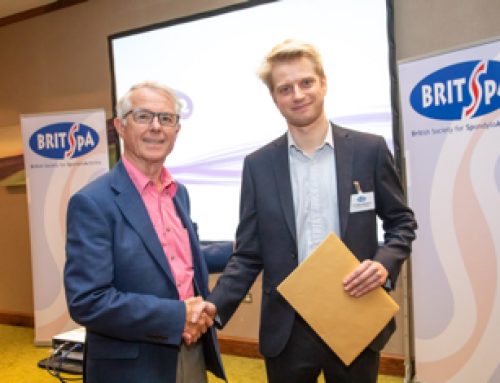This year’s BRITSpA Annual Abstract Competition had very high quality entries. The BRITSpA EC had to rate and select only 4, among which it was the 2018 Abstract Winner. Here, we include the three runner ups, all of whom had the opportunity to present their research at the BRITSpA Annual Scientific Meeting in Birmingham.
Claire Jeffries from Solent NHS Trust in Portsmouth, reported on a collaborative effort between AStretch, BRITSpA and NASS to identify hydrotherapy provision for the management of axSpA in the UK via an online survey involving physiotherapists and patients. Despite recommendations of hydrotherapy as an adjunctive therapy in the management of Axial Spondyloarthritis (AS) (NICE, 2017), hydrotherapy provision in the UK is threatened by NHS pool closures and its impact to service-users is poorly understood. Results from the survey highlighted variable provision of NHS hydrotherapy, barriers to delivery and a real threat of pool closures. The authors suggest that flexible access in flare and self-management promotion through ‘Pay-as-you-Go’ schemes may increase utilisation and preserve current services. Read the full abstract here.

Edwin Lim from Norfolk & Norwich University Hospitals reported on a combined rheumatology-radiology service evaluation to identify the prevalence and reporting standards of Computer Tomography defined sacroiliitis in patients with Inflammatory Bowel Disease imaged for non-musculoskeletal reasons.

This retrospective evaluation included CT scans from 301 patients between the ages of 18 and 55 years, with verified IBD (Crohn’s disease or Ulcerative Colitis) from the radiology imaging system between Jan 2010 and Dec 2017 was conducted. The authors found that three out of four scans had not been reported as sacroiliitis suggestive of axSpA despite being present in 20% of selected IBD patients. The use of a validated CT tool may improve reporting excellence and increase awareness of this connection. Differentiating asymptomatic sacroiliitis and a potential hidden burden of axSpA among IBD patients undergoing CT scanning for non-musculoskeletal indications may warrant further research. Read the full abstract here.
Liz Reilly from the Royal National Hospital for Rheumatic Diseases in Bath, reported on results from the PROgnostic Markers In axial Spondyloarthritis (PROMISE) study where they assessed patient reported fatigue and serum biomarkers in axSpA. Liz and collaborators evaluated a wide selection of serum biomarkers, from a large cross sectional cohort of patients with Ankylosing Spondylitis, non radiographic axial spondyloarthritis, and mechanical back pain aiming to identify biomarker signals related to patient reported fatigue, and explore the relationship with disease activity.
From this work, an association was demonstrated between fatigue and MIP1B and VEGF. Fatigue also appears to be contributing towards other PROs in our cohort. MIP1-alpha has previously been shown to decline with TNF inhibition in AS . No links however have previously been made with MIP1B in SpA. Initial work in SLE has raised the possibility that MIP1B may have a role in fatigue . In addition, therapeutic VEGF inhibition is commonly associated with fatigue. Read the full abstract here.



